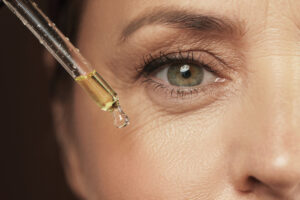Is there such a thing as male menopause?
The concept of menopause has always been associated with women. It’s a natural and well-understood biological transition that takes place with the cessation of menstruation because of the various hormonal changes.
But what about men? Do their bodies experience similar changes, and is the so-called “male menopause” a real thing? This is why we are here today. We want to see what’s behind male menopause and use all the scientific resources to do so.
This term gained traction in the last year as the centerpiece of numerous marketing campaigns for testosterone replacement therapies (TRT) and other supplements. So is male menopause just a marketing scheme?
So let’s see how male aging works and find out whether this is real.
What is the “male menopause”?
This is also known as andropause, a term that refers to the changes that take place in the male body in the late 40s and early 50s. When testosterone levels decline, decreased libido, erectile dysfunction, fatigue, and mood changes happen, and some people start to compare these changes to what happens to women when they begin menopause.
So, is this comparable to what women go through? The short answer is no, but we are going to tell you more about this, so keep reading.
Male menopause is an intriguing term, and this is the reason why some media campaigns use it. But this is an unhelpful and misleading term.

So, what are the differences?
Menopause is caused by the abrupt cessation of ovarian hormonal function, which happens when the egg reserve of women is exhausted at around 50 or 50+ years of age. In reality, there is no physiological equivalent for men, as this is impossible.
Now, it’s a fact that men’s testosterone levels start to decline in the late 30s and early 40s, but this is a gradual decline, not something so sudden as in the case of women. Also, this decline varies a lot from man to man. Some might have visible symptoms, while others can experience minimal impact.
When women enter menopause, they are no longer fertile, but even if the testosterone level of men declines, which can affect sperm production, many of them can still have children well into old age.
Even more, you need to remember that the term “male menopause” is not medically recognized. It is true that both men and women experience hormonal changes as they get older, but the process differs significantly.
Is male menopause a made-up term, then?
No, not entirely. There is a condition called late-onset hypogonadism (LOH) that is also known as functional hypogonadism, and in general, it affects older men.
When you suffer from this condition, your testosterone levels decrease drastically, and decreased libido, muscle weakness, and bone loss are some common side effects. However, late-onset hypogonadism affects only 2.1% of men, and all of them are over 65 years old.
When you hear “male menopause,” you might think that this is something more general, but in reality, as you can see, only a really small percentage of men are affected by LOH, the condition that started the male menopause craze.
How is LOH treated?
The main treatment option for LOH is testosterone replacement therapy. While it can be beneficial for some men affected by this condition, its broader application is debatable.
Doctors’ biggest concern is that TRT might be prescribed to men who show symptoms of LOH, but in reality, they have perfectly normal levels of testosterone for their age group.
These symptoms may be caused by other conditions, and it is important to consider this and not try to ignore the possibility of other underlying causes. Many symptoms men experience during aging, even before a clear decline in testosterone, can be attributed to other factors like stress, lifestyle choices, or underlying health conditions.
So before starting TRT, it is better to check for all potential causes of your symptoms.
What are the causes of these symptoms?
We know that these symptoms can be quite unsettling, and many of them can change your day-to-day life. This is exactly why it’s so important to understand what causes them.
When testosterone drops in the late 30s and early 40s, it is not unusual, but if this happens at a younger age, you can be almost sure we are talking about a health issue and not a natural decline in testosterone. If this happens, talk with your doctor immediately.
Factors like stress, depression, and anxiety can significantly impact libido, mood, and even erectile function, and because of this, they should never be ignored. Creating a term like “male menopause” can mask the real cause of these symptoms, and this is one reason it makes no sense to use it.
Another thing that can act as a trigger is obesity and related disorders. The worst part is that a vicious cycle can be created, as low testosterone levels can further contribute to weight gain.
Lifestyle changes such as healthy eating, weight management, and improved sleep habits can make a significant difference and reduce these symptoms.

Why did male menopause become so popular?
Maybe you noticed that the concept of “male menopause” has exploded in popularity in recent years. But why is this happening? Well, there are more theories.
It is not a surprise that businesses want to make a profit based on anything. The “andropause” literature, especially in the US, was born as a way to capitalize on the well-known phenomenon of menopause.
False parallels have been drawn, and this is how companies try to market testosterone-based products. Most of these products might not help at all, and there are many studies backing this up.
Since there was no market, creating one seemed like the best idea. Normal age-related changes have been labeled “male menopause,” and this is how companies that are planning to sell testosterone replacement therapy (TRT) drugs are trying to create a sense of urgency.
Many doctors consider these practices not medically justified and potentially misleading.
What happens now?
Yes, there are some men who experience genuine struggles as they age. What are they going to do?
First of all, they should schedule an appointment with their physician, as this is the most qualified person to help them. Investigating any underlying conditions is crucial when you try to find the appropriate cure. Obesity, sleep apnea, or depression are just a few of them, and you should eliminate any condition that can mimic the symptoms of the testosterone decline related to age.
Trying to have a balanced and healthy lifestyle is another thing that can help. Changes in diet and promoting healthy habits such as exercising and stress management can eliminate some of the symptoms.
Deciding if you should do testosterone replacement therapy or not might be tricky, and because of this, some help might be useful. The following book tells you everything you need to know about testosterone replacement therapy, and it might be a good read for those struggling with this decision: The Definitive Testosterone Replacement Therapy MANual: How to Optimize Your Testosterone for Lifelong Health and Happiness
You should also read: Strengthening Your Core: 6 Easy Ab Exercises for Senior Wellness



















